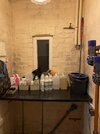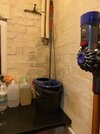Hello,
I’m after some advice please… I have a solid wall construction outrigger, previously used as a utility room but due to lack of ventilation has formed mould and damp internally.
My plan is to turn this into a downstairs toilet (same as the room directly above), I am going to create stud walls, backed with a breather membrane, filled with foiled backed insulation and finished with plasterboard. I also need to raise the floor height to line up with the existing house.
- Firstly am I ok just wiping down the walls with vinegar before commencing work, or do I need to strip it completely?
- Any better ideas for construction method?
- I assume it’s best to raise the floor and mount the studs directly to the new floor?
- Any ideas how to run services through it?
- How do I build around the window, or is it best just to build up to it?
Many Thanks
I’m after some advice please… I have a solid wall construction outrigger, previously used as a utility room but due to lack of ventilation has formed mould and damp internally.
My plan is to turn this into a downstairs toilet (same as the room directly above), I am going to create stud walls, backed with a breather membrane, filled with foiled backed insulation and finished with plasterboard. I also need to raise the floor height to line up with the existing house.
- Firstly am I ok just wiping down the walls with vinegar before commencing work, or do I need to strip it completely?
- Any better ideas for construction method?
- I assume it’s best to raise the floor and mount the studs directly to the new floor?
- Any ideas how to run services through it?
- How do I build around the window, or is it best just to build up to it?
Many Thanks




